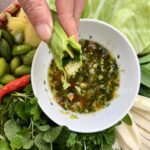Japanese rice has garnered praise for its quality, taste, and health benefits. Japonica rice, a type of Japanese rice, has also gained popularity for its aromatic flavor and health benefits. Let’s delve into what Japonica rice is, its flavor profile, and where to purchase it.
1 Introduction to Japonica Rice
What is Japonica Rice?
Japonica rice, also known as Sinica rice, is a short-grain rice native to Japan. It is one of the two primary rice varieties in Asia and is widely consumed in Japan, South Korea, China, and Taiwan. In Japan, the term ‘Japonica’ is commonly used to refer to white rice varieties.
 Japonica Rice
Japonica Rice
Origin of Japonica Rice
Japonica rice originates from Japan and was officially introduced to Vietnam several years ago. Vietnam, with its steady political climate and rapidly growing economy, provided a conducive environment for the cultivation of Japonica rice. Since 2015, the primary regions for Japonica rice production in Vietnam have been the provinces of Dong Thap and An Giang.
 Origin of Japonica Rice
Origin of Japonica Rice
Nutritional Value of Japonica Rice
The following table outlines the nutritional composition of Japonica rice, providing the nutrient content per 100g serving:
|
Energy (Calories)
|
330 ~ 350 kcal
|
|
Carbohydrates
|
77g ~ 80g
|
|
Sugar
|
0g
|
|
Protein
|
6.5g ~ 7g
|
|
Fat (Lipid)
|
0.7g ~ 0.9g
|
|
Dietary Fiber (Fibre)
|
1g
|
|
Iron
|
0.4mg ~ 1mg
|
|
Calcium
|
4mg
|
|
Potassium
|
44mg ~ 50mg
|
Additionally, Japonica rice contains vitamins B1, B2, B6, E, and PP, as well as minerals such as phosphorus, potassium, magnesium, and zinc. Japonica rice boasts an enticing aroma and a delicate, sweet taste. Its grains are plump, pearly, and uniform in size.
 Nutritional Value of Japonica Rice
Nutritional Value of Japonica Rice
2 Benefits of Japonica Rice
Japonica rice is cultivated without the use of preservatives, pesticides, or chemical fertilizers. The exceptional quality of Japonica rice can be attributed, in part, to the pristine water sources and abundant rainfall in Japan, which provide ideal natural conditions for rice cultivation. As a result, Japonica rice is safe and offers numerous health benefits for individuals of all ages.
 Benefits of Japonica Rice
Benefits of Japonica Rice
Japonica rice is rich in nutrients such as protein, fat, carbohydrates, vitamins, and minerals. It also contains significant amounts of fiber and starch, which provide energy. The presence of amino acids and folic acid in Japonica rice aids in energy regeneration. Consuming this rice helps balance blood sugar levels and boost immunity. It is particularly beneficial for individuals with liver diseases, asthma, low blood pressure, and cardiovascular issues.
3 Japonica Rice Products Available at Our Store
Japonica Rice by Ong Tho
Japonica Rice by Ong Tho features plump and glossy grains. When cooked, the rice is incredibly soft, sticky, and fragrant. In addition to being consumed as regular rice, it can also be used for making sushi and rice cakes.
Reference price: 25,500 VND/1kg bag
 Japonica Rice by Ong Tho
Japonica Rice by Ong Tho
Home Rice Japonica Rice
Home Rice Japonica Rice is cultivated and processed following stringent protocols, ensuring optimal health benefits. The rice is free from fertilizers, chemicals, and stimulants, giving you peace of mind. Its grains are plump, glossy, evenly rounded, and incredibly fragrant when cooked.
Reference price: 50,000 VND/2kg bag
 Home Rice Japonica Rice
Home Rice Japonica Rice
A An Japonica Rice
A An Japonica Rice boasts a high level of stickiness, minimal expansion during cooking, and a generous yield. It is cultivated using modern technology and does not contain any growth stimulants, making it a safe choice for consumption.
Reference price: Approximately 110,000 VND/5kg bag
 A An Japonica Rice
A An Japonica Rice
4 How to Cook Japonica Rice
 How to Cook Japonica Rice
How to Cook Japonica Rice
Cooking Japonica rice correctly results in softer, stickier grains. For the best experience, consume the rice 15-20 minutes after it has finished cooking, as this is when it tastes optimal.
5 Delicious Dishes Made with Japonica Rice
Sushi
Sushi is a familiar dish in both Japan and Vietnam. It resembles rice rolls and can be made with various ingredients such as fish, eggs, shrimp, and vegetables. Colorful sushi rolls are perfect for picnics, lunches, and snacks.
Reference:
 Sushi
Sushi
Rice Balls (Onigiri)
Onigiri, similar to rice rolls, is a staple in Japanese cuisine. They are easy to make, convenient to eat, and perfect for on-the-go meals. Japanese people often eat onigiri for breakfast or lunch or bring them along on family picnics.
Reference:
 Rice Balls (Onigiri)
Rice Balls (Onigiri)
Rice Salad (Chirashi)
For enthusiasts of Japanese cuisine, Chirashi is a must-try dish. Unlike sushi, Chirashi features fresh, colorful ingredients such as sea urchin, salmon roe, octopus, and salmon caviar. White rice is added and mixed, creating a visually appealing and flavorful dish.
 Rice Salad (Chirashi)
Rice Salad (Chirashi)
6 How to Store Japonica Rice
Japonica rice is typically stored using the MAP (Modified Atmosphere Packaging) method. The rice is milled to meet quality standards, maintaining a moisture content of <13%. It is then packaged in PE bags with a thickness of 0.05mm, further enclosed in a jute bag, and sealed. For optimal quality, consume the rice within 120 days of opening the package.
 How to Store Japonica Rice
How to Store Japonica Rice
Store Japonica rice in a cool, dry place, away from direct sunlight and high temperatures. Once the bag is opened, transfer the rice to an airtight container, such as a plastic bin or earthenware jar, to prevent insect infestation.
7 Frequently Asked Questions about Japonica Rice
Can Japonica Rice be Substituted with Jasmine Rice for Sushi?
For authentic sushi, it is not recommended to replace Japonica rice with Jasmine rice, despite suggestions that the latter can be used. Sushi made with Jasmine rice may not taste as good or have the same texture as sushi made with Japonica rice, as the grains tend to be drier and less sticky, causing the rolls to fall apart easily.
How Should Japonica Rice Be Stored for Long-Term Use?
Purchase Japonica rice that is carefully packaged and vacuum-sealed, if possible. Buy enough rice for approximately one month’s consumption. Store the rice in its original packaging or transfer it to a ziplock bag and keep it in a sealed container to maintain moisture and freshness.
 The average price of Japonica rice ranges from 25,000 to 35,000 VND per kg.
The average price of Japonica rice ranges from 25,000 to 35,000 VND per kg.
Why Do Japonica Rice Prices Vary Across Different Regions?
Japonica rice prices typically range from 25,000 to 35,000 VND per kg, depending on the production area. Prices may vary slightly between stores due to transportation costs and sourcing locations. However, if the price is significantly lower than this range, the rice may be of inferior quality, treated with chemicals, or a lower-grade blend, which could be detrimental to your health.
Where Can I Buy Authentic Japonica Rice?
Japonica rice is widely available across Vietnam, from small rice shops to large supermarkets. Our store also carries a selection of Japonica rice varieties at reasonable prices. Alternatively, you can purchase Japonica rice online from reputable e-commerce platforms like Lazada, Tiki, or Shopee, ensuring you buy from a trusted seller.
We hope you found this information helpful and that you enjoy delicious and nutritious meals with Japonica rice.
The Green Gold: Unveiling the $400 Million Agricultural Export from Vietnam to the US and Its Surprising Health Benefits.
For over two decades, Vietnam has dominated the global pepper industry, leading in both production and exports. In the first quarter of 2025, the United States, our top market, imported an impressive 10,278 tons of Vietnamese pepper. While pepper is a staple in many Vietnamese households, not many are aware of its precious medicinal value and the plethora of health benefits it offers.






































